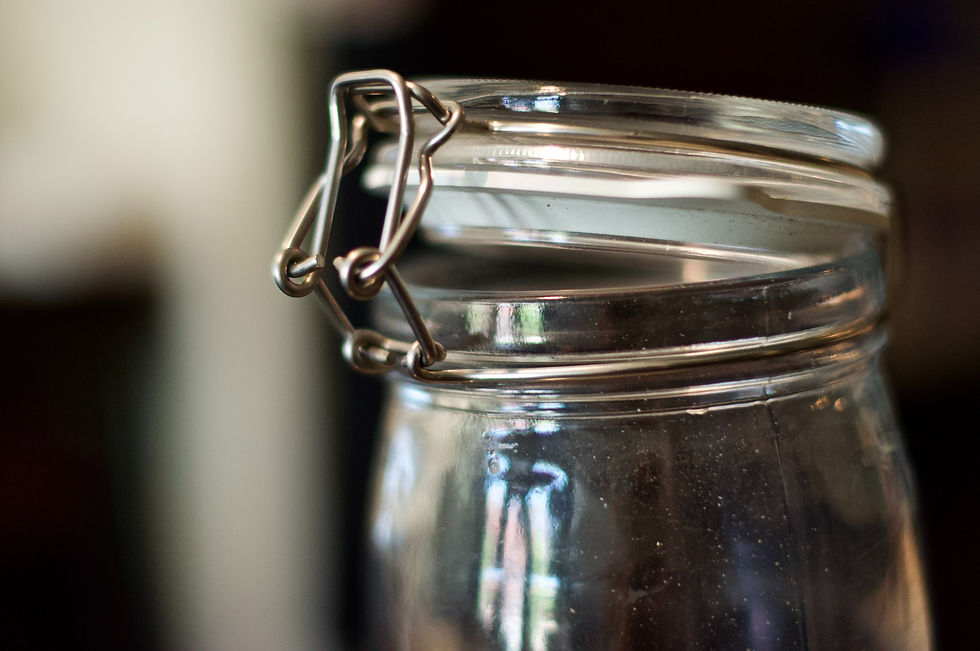How & Why to Ferment Green Beans
- Sylvia Rose

- Jan 27
- 5 min read
Updated: Feb 4
Fermentation brings layers of flavor and a range of health benefits. Green beans are nutritious, but nourishing factors can be inhibited by up to 40% indigestible fibers. Fermentation eases digestion and releases nutrients.

Fermentation has been used for thousands of years. It's a natural process in which microorganisms like bacteria and yeast transform food's taste and texture and increase nutrient availability.
Fermentation is used in production of beer, cheese, yogurt, preserved vegetables and specialties like kombucha. For vegetables, lactic acid fermentation is most commonly used.

Lactic acid fermentation uses bacteria primarily of the Lactobacillus species. Main microbes are Lactobacillus mesenteroides, L. plantarum, and L. brevis. Together they are lactic acid bacteria (LAB).
The significant species are also in the environment, on or in the food, and show up when conditions are right. The bacteria reproduce rapidly, consuming the resident lactose or milk sugar to produce lactic acid.
They prefer anaerobic conditions. If a thin white skin appears on top of the liquid, it's most likely a harmless biofilm created by the bacteria to enhance their habitat while they're working. If fuzzy or stinky it's mold. Start over.

Benefits of Fermentation
Enhanced Nutritional Profile
Fermentation improves nutrient bioavailability, making them easier to absorb. The process releases vitamins and minerals. Fermented foods are often richer in B vitamins, vitamin K2, and certain amino acids.
Probiotics for Digestive Health
One of the most renowned benefits of fermentation is the presence of probiotic bacteria like Lactobacillus spp. Probiotics promote a healthy GI tract microbiome, enhance digestion, and fortify the immune system.

Improved Digestion
Fermented foods can ease digestive issues, such as bloating and constipation. The process of fermentation pre-digests the food, making it gentler on the stomach. The enzymes produced during fermentation help in breaking down food components for better digestion.
Preservation
Fermentation naturally preserves food, extending its shelf life without need of artificial preservatives. Fermented vegetables can last several months in cool places. Before refrigeration they're a boon to the homestead.

Enhanced Flavor
The fermentation process not only preserves food but also enhances its flavor profile. The tangy taste from lactic acid production creates depth in dishes, making fermented vegetables a compliment to meals.
Support for Mental Health
There is a strong connection between digestive health and mental well-being. A healthy GI tract can benefit mood and cognitive function.

How to Ferment Green Beans
Fermenting green beans and other veggies at home is easy to do.
Ingredients
fresh green beans 454 g - 1 lb
2 cups filtered water
Sea salt (non-iodized) - up to 2.5 tsp / cup of water
optional spices and flavorings (garlic, dill, chili flakes, mustard seeds, black peppercorns)
Equipment
clean glass jar(s) - sterilize by slow boiling 10 minutes
fermentation weight or a clean stone to keep beans submerged
lid, or cloth or paper towel
rubber band or string for cloth

Instructions
Prepare the Brine: In a clean bowl, dissolve the sea salt in the filtered water to create a brine. The ideal ratio is about 2.5 tsp of salt per cup of water.
Wash and Trim Green Beans: Rinse the green beans under cold water and trim the ends, ensuring they are clean and fresh. They can be left whole or cut in bite-size pieces, at an angle to maximize surface area. Bean size can affect fermentation time.
Add Flavorings: If desired, put spices or flavorings into the jar. Try smashed garlic cloves, fresh dill, or chili flakes; however the first run should be just the legumes, to get the overall process and fermentation effects.

Pack the Beans: Next, tightly pack the green beans into the jar, standing them upright and leaving some space at the top for the brine. The beans should be snug without being crushed.
Pour the Brine: Carefully pour the brine over the green beans, ensuring they are fully submerged.
Weigh Down the Beans: To keep the beans submerged and prevent exposure to air (which can lead to mold), put a fermenting weight or clean rock on top of the beans.

Cover the Jar: Cover the jar with a cloth or paper towel secured with a rubber band or string, allowing air to escape while preventing dust and insects from entering. This won't prevent outside bacteria from jumping in.
To prevent other salt-loving bacteria or microbes, cover jar with a sealed lid and "burp" it every day or two by loosening the lid. Metal lids aren't recommended as they can rust if exposed to brine.

Ferment: Place the jar in a cool, dark place for 3 to 14 days. The length of fermentation depends on ambient temperatures and personal taste. Check the green beans periodically to be sure they stay submerged.
Taste and Store: After a few days, start tasting the beans; when they reach desired sourness, replace cloth with a lid or secure lid and store the jar in the refrigerator or cool area like root cellar. Fermented green beans can last several months.

Non-Fiction Books:
Fiction Books:
READ: Lora Ley Adventures - Germanic Mythology Fiction Series
READ: Reiker For Hire - Victorian Detective Murder Mysteries


